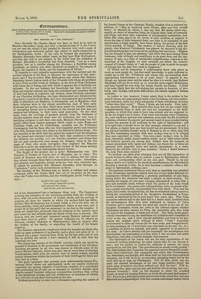< "Isis Unveiled" and the Todas (continued from page 4-242) >
The reader may rest assured that any statements concerning them that clash with the little that is above given are false. No missionary will ever catch one with his bait, nor any Badaga betray them, though he were cut to pieces. They are a people who fulfil a certain high purpose, and whose secrets are inviolable.
I was resident on the Neilgherry Hills for nearly two years, in 1852, 1858, and 1854, and afterwards again for some months in 1860. The chief Toda-mund (Toda village) was in a dell just at the back of the hotel where I each time resided. The Todas are not white as Europeans, they are brown, coffee-coloured, like most other natives; neither are they a race of giants. They are merely a stalwart race, as compared with the Badagas, not as compared with Englishmen. Their hair is coal-black. It may possibly, when excessively dirty, appear to a near-sighted person of a brownish tinge. Their huts have been entered by those who could stomach the dirt. The door is so small that one has to creep in. Up to 1852, cholera was unknown on the hills. In that year it made its first sporadic appearance; the poisoning of the artificial lake by sewerage began to tell. The medical “theory,” till then, had been that the cholera poison did not ascend more than 4,000ft. above the sea-level. Ootacamund is about 7,600ft. above the sea. The population of the hills would disappear in a few days; did thousands die at a time of any epidemic? The high land on the mountain-tops, which the Europeans and Todas inhabit, does not swarm with tigers, &c. These are but occasional visitors from the lower parts of the range, and stop a longer or shorter time, depending on the more or less ease they find in securing prey. I only saw two kinds of snakes, and neither of them was poisonous. When a tiger appears on the hills, he naturally attacks the cattle (cows, and very small ones) of the Badagas, and not the cattle (half-wild buffaloes) of the Todas. Buffaloes in a herd, and even when single, are awkward customers for a tiger. In a herd they will trample and gore their assailant to death. The Todas, at their periodical meetings, club these buffaloes to death by tens and twenties at a time. I used to wander over the hills from daylight to dusk, day after day, in the most lonely parts, with nothing but a walking-stick in my hand, and the only formidable quadrupeds I ever encountered were these same Toda buffaloes, excepting once, when I came across a pack of wild dogs, early in the morning, and had some difficulty in preventing a little spaniel with me from attracting their attention. I think it more likely that the Todas are the remains of an aboriginal tribe, driven up into the hills from the low country, than that they are of Hindu origin. Up to the time I left India, in 1862, no Brahmin or high-caste Hindu ever showed his face on the hills, unless one came, possibly, as a writer, in the train of the collector, when this latter made his occasional visits. Near Coonoon, some twelve or thirteen miles from Ootacamund, and about 1,500ft. lower, are the remains of an old hill-fortress, called Hullikulldroog, in which Tippoo confined some of his European prisoners. I have seen Toda women with infants in arms, Polyandry would not necessarily cause the population to dwindle. They are credited with polyandry similar to that existing among the “Hairs” of South-Western India, and to which is attributable the law of succession alluded to at p. 437 of the volume under notice. No Nair” is a wise man in a certain sense, and, therefore, the inheritance goes to the sister's son. Polyandry of the same kind, i.e., where two, three, or more brothers have but one wife between them, exists, according to an article in the Cornhill Magazine for January, 1878, in Thibet. About this Madame Blavatsky should be able to tell us something.
The taming of a tiger-cub is alluded to at p. 467, vol. i. I have myself seen a couple playing about in an English officer’s bungalow like a couple of huge cats. I also heard of other instances. The great secret is to keep from them the taste or smell of blood. If they once taste or smell this, they become dangerous, and it is time to destroy them. It does not do, for instance, to let them lick one’s hand, for the tiger’s tongue is so rough that it would soon fetch blood. This makes up the account of the tigress licking the fakir’s hand, at p. 623, vol. ii., appear to me doubtful. As for the remainder of the story, it may be compared with that of Major Buckley (given in Gregory’s Lectures) stopping a tiger when in the act of charging his elephant. The account of “an adept’s soul in an infant body” only seems to me to prove the possibility of mesmerising an infant, and the Delai-Lama is only a standing instance of the same fact.
Where a body, whether they be Brahmins, Buddhists, or what not, profess the principle of an inner doctrine for the initiated, and an outer (exoteric) one for outsiders, the latter can only safely receive as truths from the initiates, facts which are always and everywhere verifiable. Nothing that a Brahmin tells you about his wonder-working powers can be safely taken for gospel. He throws dust in your eyes on the principle of “omne ignotum pro magnifico.” We have here Sacerdotalism pushed to its utmost—the worst kind of selfishness, spiritual: no thought of any other being than themselves, except it be to keep each other in spiritual subjection. Such is but the natural outcome of such tenets as “conditional immortality” and “esoteric doctrines.” Those who hold them are sure gradually to look upon themselves as the “twice-born,” and all outsiders are unclean and. contaminating. I prefer the really self-sacrificing motive of the most narrow-minded missionary, be he only sincere. He seeks, in his own blind way, to elevate his fellows—Brahminists, et id genus omne, to keep them down.
Esoteric knowledge may have (p. 1, vol. i) been in the world seven thousand years, but esoteric knowledge crystallizes after two or three hundred years at the most. Diffusion of knowledge increases and preserves it, and is the only means of doing so.
Mrs. Showers on "Isis Unveiled"
Sir,—Recently Sir Charles Isham has been so kind as to send us Madame Blavatsky’s book, and after a partial perusal of it (for I have not yet read the whole) I feel puzzled to discover why such a mass of vituperation and borrowed matter has caused so much commotion in the Spiritualistic world. It can only be because the pretensions of Madame Blavatsky have misled many, as they have Miss Kislingbury, and that this lady is not solitary in the belief that the substance of Madame Blavatsky’s knowledge has been obtained, “not as a mere traveller, but as a dweller among the Hindoos; a Buddhist among Buddhists, an initiate into their mysteries as taught in the temples of Egypt, the pagodas of India, and the Lamaseries of Thibet.”
It requires no very extensive acquaintance with the customs and the modern religions of the East to discover the inaccuracy of this statement, and I beg to assure Miss Kislingbury and others that Madame Blavatsky knows just as much of the Orientals with whom she professes to have lived on such terms of intimacy, as she does of those Christians with whom she is living, and with whom it appears she is decidedly not intimate. In the one instance her knowledge has been derived not from any original sources, but from the unwearied and immortal efforts of that vast army of explorers and writers, those Christian inheritors of our Christian civilisation, who have disentombed and deciphered the long-buried records of the East, and have demonstrated and proclaimed alike to Buddhist and Brahmin, to Zoroastrian and to Egyptian, what their religions were in the almost antediluvian days of their early freshness and purity, ere they faded away under the baneful influence of corrupting forces, and in obedience to the eternal law that men and empires and religions, in their turn, must pass away. On the other hand, from the writings of apostate priests, from the testimony of obscure authors, from all those who are interested and ever busy in falsifying evidence to suit their own ends, Madame Blavatsky has diligently culled those impure passages which ought to make Pagan and Christian blush, not for Catholicism, certainly not for Protestant Christianity, but for those who can thus bespatter purity and sincerity with filth, because their own vision is too blurred to discern them. She has imputed to the faith that has gained the respect if not the allegiance of the moral and educated world—the faith that numbers in its ranks our children, our parents, and our friends—practices and crimes that did not pass unreproved even among the Romans, when in the last stage of their own social corruption they implored the Emperor Tiberius to order the destruction of that temple of Isis whose worship it is now suggested that Spiritualists should restore.
<... continues on page 4-244 >
Editor's notes
- ↑ Mrs. Showers on "Isis Unveiled" by Showers, Frederica, London Spiritualist, No. 289, March 8, 1878, pp. 115-6. in section
Sources
-
London Spiritualist, No. 289, March 8, 1878, pp. 115-6


